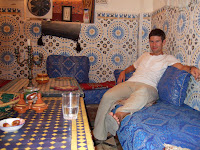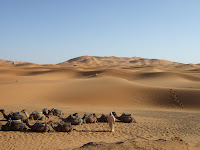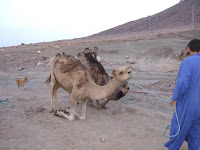 ... at least, according to the salesman at the tannery we visited here in Fes today. And who am I to argue?: I ended up buying a leather jacket and a few other items at 27% of the original asking price (that is to say, a 73% discount), which betters our previous bargaining record of knocking 38% off the price of some goods that we bought.
... at least, according to the salesman at the tannery we visited here in Fes today. And who am I to argue?: I ended up buying a leather jacket and a few other items at 27% of the original asking price (that is to say, a 73% discount), which betters our previous bargaining record of knocking 38% off the price of some goods that we bought.
But I have got a bit ahead of myself, so let me start from the start.
Today we took a guided tour of the Fes medina (which, according to our guidebook and the map we have, is impossible to negotiate without a guide). Our guide, Hamid, took us through the tortuously winding and narrow streets back in time from the 21st to the 14th and then to the 6th Century AD.
and the map we have, is impossible to negotiate without a guide). Our guide, Hamid, took us through the tortuously winding and narrow streets back in time from the 21st to the 14th and then to the 6th Century AD.
During our 4 hour tour we visited a school set in an amazing building (which also offered a panoramic view of the city from its roof), the tannery mentioned above, a carpet and rug shop (where  they showed us the weaving process), a natural pharmacy and a bronze shop (where we also saw the artisans at work). We also visited a shop selling traditional Moroccan clothes including the jilbab, a kind of airy dress worn by men and women alike. Ever since we got here, Tova has been trying to convince me that I should adopt the local ways in this respect, but despite being dressed up in this insane
they showed us the weaving process), a natural pharmacy and a bronze shop (where we also saw the artisans at work). We also visited a shop selling traditional Moroccan clothes including the jilbab, a kind of airy dress worn by men and women alike. Ever since we got here, Tova has been trying to convince me that I should adopt the local ways in this respect, but despite being dressed up in this insane  outfit today, I have decided (for the better, I think) to stick to shirts and trousers. On the other hand, I think what Tova tried on suited her very well!
outfit today, I have decided (for the better, I think) to stick to shirts and trousers. On the other hand, I think what Tova tried on suited her very well!
We ended our tour at a local restaurant where we were amongst the only tourists and ate amazing Moroccan food (and I should say that all of the food here is amazing).
 But back to the tannery and our negotiation. After being shown how the leather was made, we were offered "Moroccan whisky" (mint tea) and were taken to the various showrooms, where a plethora of leather bags, belts, cushions, jackets, shoes and every other item imaginable was on display. Everything is painstakingly handmade with natural dyes in an all-natural tanning process that is centuries-old (although apparently to "modernise" the process, the leather is now washed with some water wheels that themselves look as if they are 200 years old)! The goods are made of the leathers of various animals, depending on what they are and the quality (in order of best to lesser quality: camel/dromedary/goat, cow and sheep).
But back to the tannery and our negotiation. After being shown how the leather was made, we were offered "Moroccan whisky" (mint tea) and were taken to the various showrooms, where a plethora of leather bags, belts, cushions, jackets, shoes and every other item imaginable was on display. Everything is painstakingly handmade with natural dyes in an all-natural tanning process that is centuries-old (although apparently to "modernise" the process, the leather is now washed with some water wheels that themselves look as if they are 200 years old)! The goods are made of the leathers of various animals, depending on what they are and the quality (in order of best to lesser quality: camel/dromedary/goat, cow and sheep).
 We tried on a few jackets, looked at bags and various other things and by and by got down to a few items that we appeared to be disinterested in but actually wished to buy. We then got down to business. This is how the conversation went (prices mentioned are just indicative and not actual):
We tried on a few jackets, looked at bags and various other things and by and by got down to a few items that we appeared to be disinterested in but actually wished to buy. We then got down to business. This is how the conversation went (prices mentioned are just indicative and not actual):
JK: How much for all of this?
Saladin, our salesperson: Since you are buying so much and also because it is now hot and no one wants leather, I will take 1000 dirhams off the original price. So for this - 6000 dirhams.
JK: That is way too much! We can't afford that - we don't have any jobs at the moment and we have been travelling for a long time so we are running out of money... besides, I can buy a leather jacket for less than that in Australia! I'll offer you 1200 dirhams.
S: Oh, Mr Joshua, you know the work that has gone into these! But we make the price democratic here... in all honesty, how much are you willing to pay?
JK: Well it is true, they are well made... but Tova, do I even need a jacket? We didn't even plan to buy anything.
TG: That's true. And Australia isn't really that cold.
JK: I'll give you 1500 dirhams.
S: Oh Mr Joshua, you are worse than a Berber! Miss Tova, you are very lucky with him - he is so economique, you will be rich in just one year, inshallah!
JK: Well the thing is, we are going to get married back in Australia and that will also cost a lot...
S: Oh, I wish you good luck and long life!
JK/TG: Thank you, thank you.
S: This is your first time in Morocco?
TG: Yes it is.
S: And how do you like it?
TG/JK: Very much!
S: Inshallah! And Mr Joshua one day, inshallah, this jacket will be worn by your son. I offer you 5000 dirhams.
 And so on and so on, until we got the price right (and by the way, I had been planning to buy a leather jacket all along). All of this is done as part of a social interaction, in good faith, without aggression and with the intention of a negotiation taking place (no one expects a buyer to pay the first price stated). No price is fixed, and depends on what the buying is willing to (and can) pay, and what the seller is willing to sell for.
And so on and so on, until we got the price right (and by the way, I had been planning to buy a leather jacket all along). All of this is done as part of a social interaction, in good faith, without aggression and with the intention of a negotiation taking place (no one expects a buyer to pay the first price stated). No price is fixed, and depends on what the buying is willing to (and can) pay, and what the seller is willing to sell for.
Anyway, negotiating is great fun, and it is almost worth doing it just for the entertainment-value (although we'd go broke pretty quickly if we did that!). Part of our bargain was to give publicity to the tannery (which is a cooperative), so here goes:
Merveilles de Cuir, Terrasse de Tannerie
43, Derb Rhorba Gurniz
Fes Medina (opposite the Museum Belghazi)
T: +212 (0)35 636 194 or +212 (0)61 835 535
I highly recommend it!
 For those of you who know me in Australia, you also probably know I can be a bit of a picky eater. Six months ago you probably couldn't have gotten me near a fish finger, let alone a plate of sardines. My, how things change! Today for lunch Josh and I woolfed down a plate of delicious BBQ sardines here in Essaouria, fished out of the Atlantic Ocean that morning.
For those of you who know me in Australia, you also probably know I can be a bit of a picky eater. Six months ago you probably couldn't have gotten me near a fish finger, let alone a plate of sardines. My, how things change! Today for lunch Josh and I woolfed down a plate of delicious BBQ sardines here in Essaouria, fished out of the Atlantic Ocean that morning. But this isn't like eating just any fish - you have to work for your meal. They are cooked whole and you have to scrape off the scales, de-bone and de-gut them before you can eat. This does get a little tiring and the guts can turn you off your meal, but it's worth it. We do it the Portuguese way - with knife and fork - however we were introduced to the Moroccan way today which involves only your fingers!
But this isn't like eating just any fish - you have to work for your meal. They are cooked whole and you have to scrape off the scales, de-bone and de-gut them before you can eat. This does get a little tiring and the guts can turn you off your meal, but it's worth it. We do it the Portuguese way - with knife and fork - however we were introduced to the Moroccan way today which involves only your fingers!


 In order to escape the furnace that is Agadir, I'm going to update you on what you've no doubt all been dying to hear: Moroccan food. These are some of the observations I've made over the past three weeks:
In order to escape the furnace that is Agadir, I'm going to update you on what you've no doubt all been dying to hear: Moroccan food. These are some of the observations I've made over the past three weeks:



















 What we saw were real Saharan sand dunes, just like you'd imagine them. It was simply amazing and watching the sunset and sunrise from the top of the dunes was beautiful. From where I was, the only noise I could hear was my watch ticking.
What we saw were real Saharan sand dunes, just like you'd imagine them. It was simply amazing and watching the sunset and sunrise from the top of the dunes was beautiful. From where I was, the only noise I could hear was my watch ticking.























